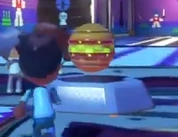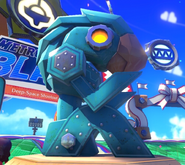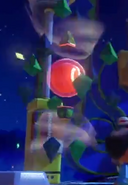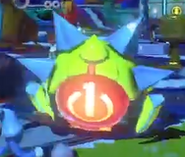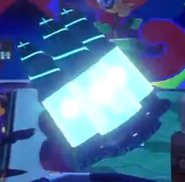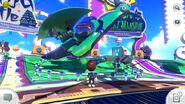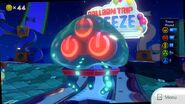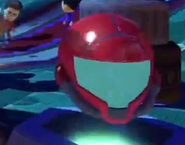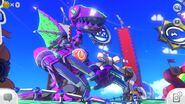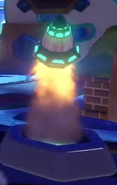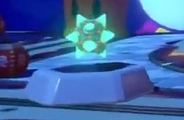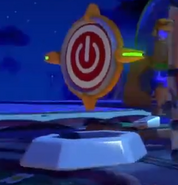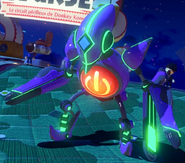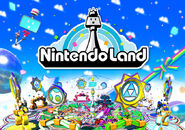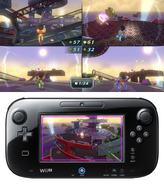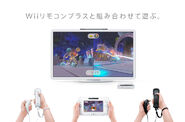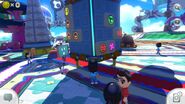PeabodySam (talk | contribs) m (→Enemies) |
PeabodySam (talk | contribs) m (→Soundtrack) |
||
| Line 108: | Line 108: | ||
===Soundtrack=== |
===Soundtrack=== |
||
| ⚫ | The score for ''Nintendo Land'', and its many attractions, was composed by Ryo Nagamatsu. Like the different visual themes of the minigames, each attraction has a unique soundtrack style. Metroid Blast's soundtrack is fully orchestrated, with some synths added to [[Vs. Meta Ridley|Ridley's theme]]. Many themes add additional instruments when the players are battling enemies. |
||
| − | |||
{{cquotetxt|''Metroid Blast is the most complex attraction in Nintendo Land, one that gives you a really full-on action experience. I gave the music an orchestral arrangement for an epic, flamboyant sound, something that made you feel you were playing inside an enormous space.'' |
{{cquotetxt|''Metroid Blast is the most complex attraction in Nintendo Land, one that gives you a really full-on action experience. I gave the music an orchestral arrangement for an epic, flamboyant sound, something that made you feel you were playing inside an enormous space.'' |
||
''The chorus you hear in the arrangement of [[Super Metroid]]'s 'Lower Norfair' music is composed entirely with my own voice, without any processing.'' |
''The chorus you hear in the arrangement of [[Super Metroid]]'s 'Lower Norfair' music is composed entirely with my own voice, without any processing.'' |
||
| − | ''There's a lot of original music here, too, songs that retain that grand sort of Metroid impact. I hope it'll help players really lose themselves as they're thrown into battle inside this massive space!''|Ryo Nagamatsu |
+ | ''There's a lot of original music here, too, songs that retain that grand sort of Metroid impact. I hope it'll help players really lose themselves as they're thrown into battle inside this massive space!''|Ryo Nagamatsu<ref>[https://www.destructoid.com/an-aural-tour-with-the-composer-of-nintendo-land-part-2-242635.phtml]</ref>|color=gray|size=300%}} |
| + | |||
| ⚫ | The score for ''Nintendo Land'', and its many attractions, was composed by Ryo Nagamatsu. Like the different visual themes of the minigames, each attraction has a unique soundtrack style. Metroid Blast's soundtrack is fully orchestrated, with some synths added to [[Vs. Meta Ridley|Ridley's theme]]. Many themes add additional instruments when the players are battling enemies. Many of the themes are remixes of classic ''Metroid'' themes, like [[Brinstar (Metroid)|Brinstar]] (also including an arrangement for the battle against Kraid, heard [https://www.youtube.com/watch?v=KZAX4pEdhbQ here]) or [[Magmoor Caverns (theme)|Magmoor Caverns]]. The tutorial uses an original theme containing aspects of the Brinstar theme (heard [https://www.youtube.com/watch?v=BZJ8-TFy5JY here]). The Training Zone, Ice Sector, and Sea Tower stages use original, "triumphant" themes (heard [https://www.youtube.com/watch?v=YcVi8ENyfyg here], [https://www.youtube.com/watch?v=isQwysgv2Jw here] and [https://www.youtube.com/watch?v=aBP7Iv88oYk here], respectively). The iconic [[Title (Metroid)|title theme]] is used when selecting the game modes. |
||
==Coin Game Prizes== |
==Coin Game Prizes== |
||
Revision as of 22:16, 26 November 2018
| This article is written from the Real Life point of view |
Nintendo Land (ニンテンドーランド Nintendō Rando) is a party game for Wii U that integrates Miis into a Nintendo theme park of games. These games are based on 12 Nintendo franchises, each one providing unique gameplay experiences for either one or up to five players. The multiplayer centric games feature Asymmetric Gameplay, where one player uses the Wii U Gamepad to play the game in a certain way, while the other players use Wii Remotes for a different type of gameplay within the same game.
In this game, Miis dress as the characters from one of the 12 included series in a Nintendo Land theme park to play a related game (referred to as "attractions") using the Wii U GamePad and Wii Remotes. They can also unlock prizes to be displayed in Nintendo Land Plaza, with many of these prizes relating to objects and enemies from the different attractions.
A Metroid-themed game called Battle Mii was shown at E3 2011. The following year, at E3 2012, Nintendo announced that it would be one of the attractions in Nintendo Land, now renamed as Metroid Blast.
Nintendo Land was released with the console's launch in North America on November 18, 2012, in Europe on November 30, 2012, and in Japan on December 8, 2012. It is also a pack-in disc game with the Deluxe/Premium Bundles of the console in North America, Europe, and Australia.[1]
Metroid Blast
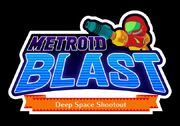
Attraction logo for Metroid Blast.
Promoting itself as a Deep-Space Shootout, the game is one of the 12 Nintendo-themed subgames accessible from the main hub of Nintendo Land. It is a multiplayer competitive and cooperative shooter game for up to 5 players - four of them controlling controlling Miis dressed as Samus (Varia Suit, Fusion Suit, Green Samus, and Gravity Suit) using Wii Remote+ & Nunchuk and the remaining player piloting Samus' Gunship with the Wii U Gamepad. This attraction is one of the few that also allows solo play, with either the Wii Remote+ & Nunchuk or the GamePad available for the lone player.
The Wii Remote players play on the main TV with pointer controls while the Gamepad user plays on his/her own screen using a dual analog and gyro configuration to control the ship's altitude, aiming, and movement at once.
Abilities
Wii Remote Players:
- The Morph Ball, allows faster movement while becoming a smaller target but Samus is kicked out if shot.
- The Grapple Beam, deploys from the left arm while being carried around by the Gunship, it launches from the right arm when used on grapple points.
- Zoom, featuring the same HUD used in Other M.
- Dodge, by a shake of the Wii Remote.
- A charge shot that fires a Charge Bomb.
GamePad Players:
- A quick dash move in the direction the control stick is pointing, has a short recharge time.
- A charge shot that fires a Missile in a straight line.
- A Zoom-in feature using the left trigger.
Stages
- "Space Port" redirects here. For the room in Metroid: Other M, see Spaceport.
Five stages are available in the Surface-Air Combat and Ground Battle modes; the majority of Assault Mission levels are also set in these stages.
- Training Zone: This stage evokes the appearance of a virtual world, with black structures covered with neon-colored grid patterns. The center of the stage is a large tower displaying an 8-bit Metroid larva sprite from Metroid. An original adventurous theme always plays on this stage.
- Space Port: This stage is set in a nighttime setting, appearing as a base full of crates, spotlights, and high-tech towers. Brinstar (Metroid) plays on this stage, unless players are battling Ridley in Assault Mission.
- Volcanic Sector: This stage is set around a large pit of lava in the center. In Assault Mission, Kraid is always battled in this stage, where he occupies the lava pool. Magmoor Caverns plays on this stage, unless players are battling Kraid.
- Sea Tower: This stage is a large rig floating on a sea of purple liquid, featuring several color-coded levels rising up to the purple central tower. This may be a Space Pirate base, since Zebesians are always fought here during Assault Mission. An original woodwind theme always plays on this stage.
- Ice Sector: This stage is an ice-covered cavern, with additional tunnels below. A Chozo Statue can be found on this stage, usually with an item pickup in front of it. An original winter theme plays on this stage, unless players are battling Ridley in Assault Mission.
Assault Mission features an additional unnamed stage that is not playable in Surface-Air Combat or Ground Battle. It features a similar aesthetic to the Training Zone, with dark surfaces highlighted by a neon blue grid pattern. The tutorial takes place here, as well as missions "1. First Contact" and "29. On Familiar Ground".
Items
Several items appear inside a floating crystal-like container. Shooting the container will drop the item, allowing Samus Miis to collect them. Gunship Miis can simply fly into the container to pick up the item. However, if an item is shot outside of its container, it will disappear.
- Life +1: A healing heart that replenishes one hit point. These may also be dropped from defeated enemies.
- Shield: An invincibility shield that last 10 seconds. Randomly acquired from a Question Mark.
- Rapid-Fire Helmet: A helmet that increases the normal beam firing rate. If the user gets hit while wearing this helmet, they will lose the upgrade but will not take damage from the attack. Randomly acquired from a Question Mark.
- Ice Charge Shot: An upgrade that replaces the default charge shot for a freezing shot that charges and travels faster than the Charge Bomb or Missile, but deals no damage. Unlike all other items, these are not contained in containers and are placed in predetermined locations in the stage during select missions.
- Golden Helmet: If Miis have failed a mission twice, Monita will offer a helmet that doubles the user's hit points and firing rate. However, a mission cannot be Mastered if this assist item is used.
Enemies
The game presents a variety of classic and original enemies to defeat in Assault Mission mode. Every attraction in Nintendo Land has a distintic aesthetic theme (Zelda Battle Quest has everything made of cloth, Takamaru's Ninja Castle is made of Origami, etc.), and in Metroid Blast, being a Sci-Fi game, all the enemies are animatronic versions of the real creatures. All of them have a weak spot in the chest, represented by a "On-Off" power button; red buttons must be shot once, yellow buttons must be shot twice, and blue buttons must be shot thrice.
- Geemer: Ground enemies that chase the characters; they can walk over walls. They come in three types: green (1 hit point), purple (3 hit points, can fire homing Rockets), and red (1 hit point, will explode with a large blast radius when destroyed).
- Zebesian: Based on the Space Pirates seen in the 2D Metroid games and Other M. Grounded or flying enemies with ranged and melee attacks. They come in multiple variants: normal (3 hit points), ice (can fire freezing shots, which can freeze other enemies as well), red (3 hits from the front and 3 on the back are required to defeat them), and sniper (only 1 hit point, but with increased range and accuracy). Normal and ice variants may be either grounded or flying; the red and sniper variants are only grounded.
- Cyclon: Airborne enemy, it floats slowly around the area until threatened, when it turns into a whirlwind and chases the player. They are vulnerable to normal shots only when they expose their weak spot, but a charge shot can destroy them at any time.
- Cyclon Queen: A larger version of a Cyclon, it summons Cyclons constantly to protect herself. To damage it, the players have to wait until it opens its two halves and exposes its weak spot (similar to Spore Spawn). It requires 3 hits to be defeated.
- Metroid: This enemy hovers through the area searching for the players. If it finds one, it charges forward to it in a straight line. The only way to destroy them is using the Ice beam upgrade to freeze them, then shoot at its three separate hit points in its nuclei. If they grab onto a player, there is no way to shake it off. If an ally Mii is grabbed by a Metroid, they can be shot by a player to force them to safely let go of the Mii.
- Kraid: He is the boss in three missions. He occupies the center of the Volcanic Sector and has a 360 degree of range. Unlike the rest of the enemies, Kraid is stationary and can only rotate on its own axis. His attacks are mostly long-range projectiles and get added as the battle progresses. They include:
- Explosive boomerang-like claws thrown from his hands.
- Rockets fired from his shoulders
- Releasing Zebesian Space Pirates from his body.
- Lasers
- Bullets
- Energy spheres; these last three attacks are fired from various locations on his body.
- To damage Kraid, players have to hit him in the nose, and then fire a charged shot directly to his throat so it flies down inside his chest. After every three direct hits, he will rise higher and higher from the lava, revealing more weapons and targets spread across his body. He also begins extending platforms carrying Pirates from within his body, revealing Kraid to be a sort of fortress. If there is at least one Wii Remote player plus a Gamepad player, the one with the gunship can carry the other one right into Kraid's throat and let the Mii fall directly inside his chest, allowing the Wiimote user to directly damage the weakpoint with standard beam fire. During mission "24. Kraid's Army", Cyclons and Geemers are added to the area to increase the overall difficulty.
- Ridley: He is the boss in four missions, and appears as an assist enemy in others. In addition to his color scheme being derived from his original Metroid sprite, Ridley's in-game depiction appears to have been inspired by Meta Ridley, as his attacks and battle theme are similar to his Prime counterpart. His attacks include:
- A long and very accurate plasma laser beam.
- Multiple plasma shots fired from his mouth.
- Multiple Rockets fired from his back.
- Spike Bomb carpeting the area.
- A forward thrust of his retractable tail.
- Deploying his right hand to grab the Mii.
- If a Mii is successfully grabbed, Ridley holds the Mii up to his mouth and breathes plasma at them, similar to one of his attacks in Zero Mission.
- Firing plasma shots from his left hand.
- To damage Ridley, the players have to hit his many weak spots, located in his mouth, chest, tail, and hands. Once all of these hit spots have been damaged enough, another large weak spot appears on his back side, and this spot is the one that lowers Ridley's health. This sequence has to be performed thrice to defeat him. If Ridley does not have a displayed health bar, then it may not be possible to defeat him during that mission; for example, during mission "7. Destroy 10 Cyclons", he will fly away after the buttons on his mouth, chest, and tail have been destroyed. Later missions introduce Ice Ridley, whose attacks gain freezing properties. In mission "28. Ridley and Ice Ridley", both versions of Ridley will fight the players at once. The final bonus mission, "30. The True Final Battle", has Ridley fighting alongside Kraid; since Ridley will keep regenerating his armor, only Kraid can actually be defeated, and doing so will cause both bosses to explode simultaneously.
Game Modes
The attraction offers three basic game modes: Assault Mission, Surface-Air Combat (known as Land vs Air in PAL versions), and Ground Battle.
In Assault Mission, 1 to 5 players can engage in various challenges as a team, many of them involving defeating waves of incoming enemies.
Surface-Air Combat and Ground Battle are competitive game modes, where 2 to 5 players (2 to 4 in Ground Battle) battle against each other in a traditional Deathmatch game. On Ground Battle, only Wii Remote players will participate, with the GamePad acting as the "LIVE" camera. Completing levels from Assault Mission unlocks additional set rules for both these game modes.
Soundtrack
| “ | Metroid Blast is the most complex attraction in Nintendo Land, one that gives you a really full-on action experience. I gave the music an orchestral arrangement for an epic, flamboyant sound, something that made you feel you were playing inside an enormous space.
The chorus you hear in the arrangement of Super Metroid's 'Lower Norfair' music is composed entirely with my own voice, without any processing. There's a lot of original music here, too, songs that retain that grand sort of Metroid impact. I hope it'll help players really lose themselves as they're thrown into battle inside this massive space! |
„ |
—Ryo Nagamatsu[2] | ||
The score for Nintendo Land, and its many attractions, was composed by Ryo Nagamatsu. Like the different visual themes of the minigames, each attraction has a unique soundtrack style. Metroid Blast's soundtrack is fully orchestrated, with some synths added to Ridley's theme. Many themes add additional instruments when the players are battling enemies. Many of the themes are remixes of classic Metroid themes, like Brinstar (also including an arrangement for the battle against Kraid, heard here) or Magmoor Caverns. The tutorial uses an original theme containing aspects of the Brinstar theme (heard here). The Training Zone, Ice Sector, and Sea Tower stages use original, "triumphant" themes (heard here, here and here, respectively). The iconic title theme is used when selecting the game modes.
Coin Game Prizes
The pachinko-style machine in the center of the park uses coins collected in the park attractions in exchange for prizes that are displayed in the central plaza. Among these 200 prizes are several Metroid Blast items and 8 songs for the Jukebox. Some of these items have never actually been featured in a Metroid game. When activated, the prizes usually perform a certain function, while a description flashes onscreen and Monita reads their name.
- Charge Bomb: Effective in ground combat, bombs detonate after approximately three seconds. They roll if they hit the ground, making them a little tricky to use. Just keep practicing...from a safe distance.
- Chozo Statue: The highly advanced Chozo were once a great civilization, but this greatness cost them dearly and resulted in their ultimate demise...
- Cyclon: Cyclons can expand outward to form a powerful tornado, but this exposes their weak spot. This means they're not afraid to show their sensitive side. I do like that in a robot.
- Geemer: Geemers seem to crawl along harmlessly at first, but they'll spring at you if you get too close! Whatever you do, don't let them surround you. These lovable creatures can climb up walls, too!
- Gunship: This is Samus Aran's sleek and stylish mode of galactic travel. The controls take some getting used to, but believe me--once you start soaring through the sky, you'll be hooked!
- Ice Charge Shot: This handy weapon freezes enemies on the spot. It also doubles as an excellent ice-cube maker in the summer. Almost as refreshing as a high-performance aluminum heat sink!
- Kraid: This hulking monstrosity dwells in the depths of planet Zebes. His skin is impenetrably thick, so try shooting into his mouth. You'll have to climb his towering body to reach his face!
- Metroid: This genetically engineered life-form leeches energy from living things. Freeze it to expose its weak spots.
- Missile: The Gunship's missiles have a huge blast radius, so they're useful against players who like to hide. Just make sure you don't get caught in the blast yourself!
- Morph Ball: Samus's Power Suit can morph into a ball, letting the player squeeze through narrow passages and deploy bombs. You can't place bombs as a Morph Ball in Nintendo Land, but you'll still move like the real thing!
- Rapid-Fire Helmet: This is the highly advanced helmet of bounty hunter Samus Aran. Now with rapid-fire beam-shooting ability! (Exclusive to Nintendo Land. Only available while supplies last.)
- Ridley: Violent, villainous, and highly intelligent, Ridley is Samus's nemesis, commander of the Space Pirates, and the galaxy's greatest threat. Attack him from the back when he's stunned.
- Rocket: This enemy weapon leaves a trail of black smoke in its wake.
- Spike Bomb: Enemies scatter these nasty bombs from above. How they carry them is a complete mystery.
- Target: Fire beams and bombs at targets. They move nice and smoothly, making them ideal for practice. You might win the entire game if you shoot them all. Sorry, that was completely untrue.
- Zebesian: The Zebesians are a race of Space Pirates from the Planet Zebes. Though the skill is unnecessary for everyday life, they can fire beams from their scissor-like appendages. What a plus.
Trivia
- Metroid Blast was originally designed as a Star Fox attraction, but the helicopter-like controls of the ship were not conducive to the Arwing.[citation needed]
- Complementing the power-button theme found on enemies, Samus Aran's Gunship has composite inputs on one side and PC audio connectors on the other. [3]
- Metroid Blast has the most soundtracks available in the music box at the main plaza, with up to 8 slots.
- In all of the events in Assault Mission, Ridley will materialize out of thin air, while Kraid will always emerge from the ground. This may be an homage to the characters' introductions in Super Metroid.
Gallery
References
- ^ a b c d Wii U coming to America Sunday, November 18. Ars Technica. Retrieved on 13 September 2012.
- ^ [1]
- ^ http://www.polygon.com/2012/12/12/3757884/nintendo-land-the-postmortem-interview

